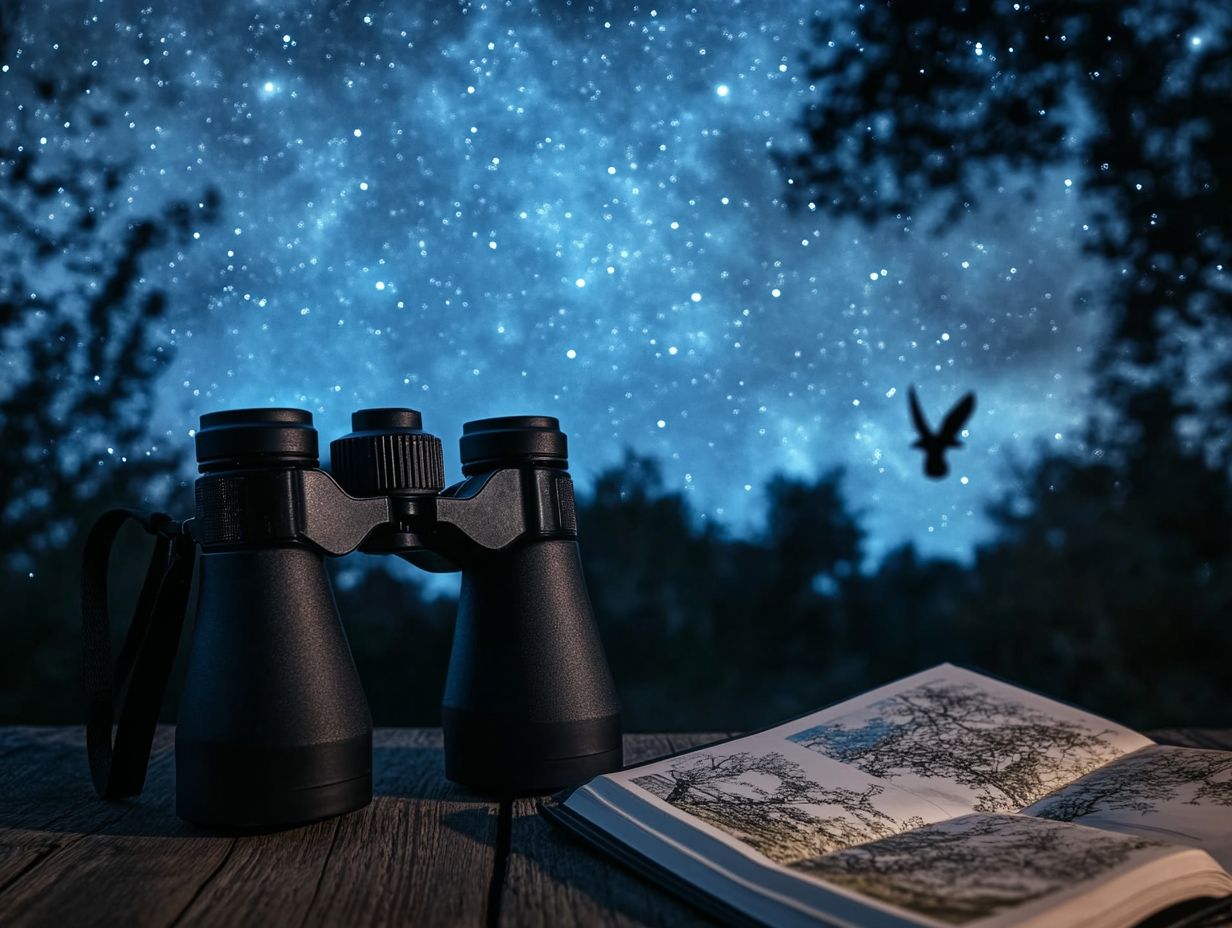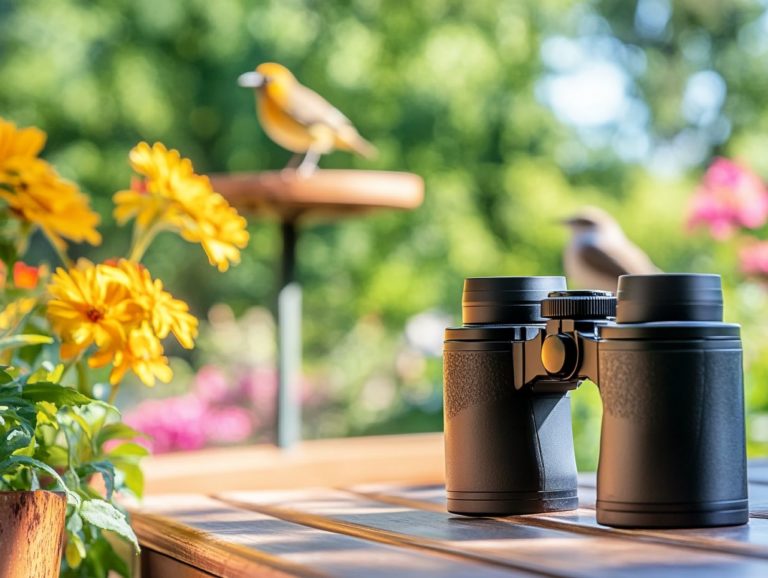Best Binoculars for Bird Watching at Night
Bird watching at night unveils an entirely new realm of bird-watching adventures. To genuinely appreciate the splendor of nocturnal species, you need the right binoculars.
This guide delves into the essential features that make certain binoculars more suitable for nighttime observation. From magnification and lens size to low-light performance and durability, it highlights the key factors that can elevate your bird-watching experience after dark.
Whether you re a seasoned bird watcher or a novice eager to explore, this overview will assist you in selecting the perfect binoculars for your nighttime excursions.
Contents
- Key Takeaways:
- 1. Magnification and Lens Size
- 2. Image Quality and Brightness
- 3. Low Light Performance
- 4. Durability and Weather Resistance
- 5. Size and Weight
- 6. Close Focus Distance
- 7. Field of View
- 8. Prism Type
- 9. Eye Relief
- 10. Focus Type
- 11. Accessories
- 12. Brand and Price
- 13. Customer Reviews
- 14. Warranty and Return Policy
- Frequently Asked Questions
- What are the best binoculars for bird watching at night?
- Are there any specific features to look for in binoculars for bird watching at night?
- Do I need to use a tripod when using binoculars for bird watching at night?
- What is the difference between night vision binoculars and regular binoculars for bird watching?
- Can I use binoculars for bird watching at night without any special equipment?
- What is the price range for binoculars for bird watching at night?
Key Takeaways:

- Choose binoculars with higher magnification and larger lenses for better clarity and detail in low-light conditions.
- Look for high-quality optics and lenses that provide bright, clear images for optimal bird watching at night.
- Choose binoculars that have special low-light features, such as coated lenses and larger exit pupils, for optimal viewing in low-light environments.
1. Magnification and Lens Size
When choosing binoculars for bird watching, it’s vital to understand the importance of magnification and lens size. Magnification dictates how closely you can observe distant birds, while lens size influences light intake. For the best experience, consider the top 5 binoculars for bird watching at home.
Opting for a higher magnification level, such as 10x, allows you to spot intricate details on a distant bird, like the mesmerizing patterns on its feathers. However, balancing this with an appropriate lens size is crucial; larger lenses, like those found in 42mm models, let in more light, ensuring clearer views during low-light scenarios such as dawn or dusk.
There are various binocular styles to suit different needs:
- Compact 8×32 for casual outings.
- Powerful 10×50 for serious observation.
Each choice influences clarity, brightness, and your overall comfort, directly affecting how you connect with nature.
2. Image Quality and Brightness
Image quality and brightness are crucial elements that significantly impact how well your binoculars work, especially when navigating the diverse visibility conditions that bird watchers often encounter.
To immerse yourself in the avian world, it s essential to consider how various factors work together to enhance clarity and detail. Quality lens coatings play a vital role by reducing glare and improving light transmission.
For those who frequently explore low-light habitats at dawn or dusk, the brightness levels of your binoculars are essential. It’s during these moments that choosing the right binoculars for bird watching truly makes a difference, delivering an exceptional viewing experience. You’ll be amazed by the perfect mix of technology and craftsmanship that provides stunning imagery in all conditions.
3. Low Light Performance
Low light performance is essential for birders who often pursue this passion during the enchanting hours of dawn or dusk. During these times, visibility can be a challenge, making optical clarity and effective light transmission absolutely crucial. Investing in the best binoculars for bird watching on a budget can greatly enhance your experience.
To elevate your viewing experience, you can explore different binocular designs that boast advanced optical technologies. For example, extra-low dispersion (ED) lenses are pivotal in reducing color distortion, ensuring you capture sharper images even as light fades.
Field tests frequently demonstrate that models from esteemed manufacturers like Zeiss and Swarovski shine in low-light scenarios, showcasing remarkable light-gathering abilities and contrast.
You ll notice significant differences when comparing these premium options with more standard models, especially in twilight conditions where every detail counts. Investing in binoculars that feature superior optical technology not only enhances your visibility but also deepens your appreciation of nature’s splendor.
Take your bird-watching to the next level by choosing the right binoculars today!
4. Durability and Weather Resistance
Durability and weather resistance are essential features for binoculars in the birding community, especially when you’re out in the elements facing harsh conditions.
Rugged designs with reinforced housing, along with waterproofing and shock resistance, ensure that these critical tools can stand up to whatever nature throws at them. Take the Nikon Monarch 5, for example; it’s not just waterproof but also fog-proof, making it a perfect choice for those unpredictable weather shifts.
The Vortex Viper HD offers a tough exterior that resists bumps and drops particularly crucial for birders navigating challenging terrains during events like the Crane Festival.
You can fully immerse yourself in the beauty of nature, all while knowing your equipment won t let you down.
5. Size and Weight

The size and weight of binoculars are essential factors that influence your handling and comfort, particularly during those extended bird-watching sessions where comfort should go hand in hand with functionality.
For those who revel in hours spent observing avian wonders, the weight of heavier models can become a burden. This can lead to discomfort and fatigue that ultimately detracts from the overall experience.
There s a variety of sizes available to suit your preferences. While larger models may offer exceptional light-gathering capabilities the ability to capture light for clearer images they often come with the drawback of added weight.
In contrast, compact and lightweight binoculars are gaining traction among birders who value mobility and ease of use while refusing to compromise on optical clarity.
Consider options like the Zeiss Terra ED or the Nikon Monarch M5, which strike an excellent balance. These models allow you to enjoy prolonged viewing with minimal strain while still delivering impressive image quality.
6. Close Focus Distance
Close focus distance is a feature you may overlook, but it can truly elevate your bird-watching experience, allowing you to observe small birds and intricate details from remarkably short distances.
This characteristic varies significantly among different binocular models, influencing how effectively you can appreciate your surroundings. For instance, compact models like the Nikon Prostaff 7s boast a close focus distance of just 6.5 feet, making them perfect for examining insects or flowers up close.
High-end options such as the Zeiss Conquest HD offer exceptional close focus abilities at approximately 4.9 feet, enabling you to make detailed observations of wildlife in a more intimate setting.
These features can transform an ordinary field test into an immersive experience, allowing you to capture fleeting moments that often slip away at greater distances.
7. Field of View
The field of view is a critical performance criterion for you as a birder. It determines how much of the landscape you can see at a glance, making spotting moving birds notably easier.
A wide field of view significantly enhances the overall experience for those immersed in bird-watching. It allows you to track birds in flight or swiftly scan expansive areas without the hassle of constantly adjusting your binoculars.
Consider binoculars with a wide field of view, like those boasting 8×42 magnification and a remarkable 420-foot view at 1,000 yards. These enable you to capture the action more fluidly compared to models with a narrower view, which might only offer around 300 feet at the same distance.
Choosing the right gear can truly make the difference between catching a fleeting glimpse of a rare species or missing it entirely. Don’t miss out on that fleeting glimpse! This becomes especially crucial in environments where birds flit between branches or dart through underbrush, making a wide view the preferred choice for seasoned birders like yourself.
8. Prism Type
The type of prism used in binoculars is crucial for how well you can see through them, affecting key elements like image brightness, clarity, and overall quality. These factors are essential for serious birdwatchers.
You ll encounter various prism types, such as Schmidt-Pechan and Porro, each offering distinct advantages. Schmidt-Pechan prisms are known for their compact design, providing a slimmer profile and lighter weight. They are perfect for those who prioritize portability during lengthy outings.
Porro prisms also provide better depth perception and a wider field of view. This makes them a favorite among birders who seek a more immersive experience.
Understanding these differences helps you align binocular features with your specific birding habits. This way, you can ensure you get the most out of your outdoor adventures.
9. Eye Relief
Eye relief is how far away your eye can be from the eyepiece and still see everything clearly. It is a crucial aspect of comfort and usability in binoculars, especially if you wear glasses.
Grasping this concept can greatly enhance your birdwatching experience, helping you catch every detail while observing your feathered friends. If you lean toward compact models, look for a minimum eye relief of 14mm to comfortably accommodate your eyeglasses. In contrast, full-size binoculars usually provide longer eye relief, often exceeding 16mm.
As a birder, you might have specific preferences; for example, a wider field of view could be invaluable for spotting birds in flight. Selecting binoculars with the right eye relief not only boosts your comfort but also optimizes the overall viewing experience, catering to your unique visual needs.
10. Focus Type

Understanding the focus type is essential for making choices that suit your specific needs.
The focus type you choose whether center focus or individual focus directly affects how quickly you can adjust and your efficiency. This choice is crucial for optimal viewing.
Center focus models are often favored for their swift adjustments, allowing you to change your gaze from one subject to another without the hassle of fine-tuning separate eyepieces. This feature is particularly advantageous in dynamic birding situations, like when observing a flock in flight. Brands like Nikon, Vortex, and Leica exemplify this type with their versatile binoculars that streamline the focusing experience.
On the flip side, individual focus options offer precise control, making them ideal for stationary viewing of distant subjects. Models from brands like Zeiss and Swarovski showcase this strength. Each focus type has its strengths and weaknesses, influencing your experience based on your specific needs and the environments you explore.
11. Accessories
Understanding the right birding gear can significantly improve your experience.
Accessories are critical for enhancing your bird-watching experience, adding convenience and functionality to your binoculars.
These tools not only boost comfort but also optimize your performance during extended hours spent observing nature. For instance, harnesses can evenly distribute the weight of your binoculars, alleviating fatigue and allowing you to focus on spotting those elusive species.
Cases protect your delicate equipment from the elements while keeping everything organized and within easy reach. Tripod adapters provide stable viewing, which is especially beneficial if you prefer taking your time studying birds in detail.
A lens cleaning kit is essential for maintaining clarity during your observations, ensuring nothing obstructs that perfect sighting. Invest in accessories tailored to your specific needs, whether you prioritize portability, durability, or enhanced visibility. Consider the price categories available for these essential items as well.
12. Brand and Price
Understanding the price of binoculars is essential for making an informed choice.
When selecting binoculars, you’ll find that brand reputation and price play crucial roles in determining quality and performance. Premium brands often offer superior lenses that justify their higher costs.
Discover the unbeatable quality of premium brands! Take luxury brands like Leica, for example. They’re renowned for their exceptional glass quality and precision engineering, resulting in razor-sharp images, even in low light conditions.
If you re looking for something more budget-friendly, consider:
- Vortex
- Maven
- Steiner
These brands offer robust performance that meets the needs of outdoor enthusiasts without straining your wallet. Maven perfectly balances affordability with premium features, appealing to those seeking high-end specifications without the steep price tag typically associated with top-tier options like Zeiss and Swarovski.
Each brand caters to different user expectations, ensuring that whether you re a casual birdwatcher or a dedicated wildlife enthusiast, you ll find options that deliver exceptional value within your desired price/value range.
13. Customer Reviews
When evaluating options, consider binocular reviews for informed decisions.
Customer reviews provide invaluable insights into actual performance and reliability, serving as a guiding light for your decision-making journey, particularly within the birding community.
These user experiences highlight essential features like:
- Usability in different weather conditions
- Optical clarity that can either elevate or ruin a wildlife sighting
- Durability needed for rugged outdoor escapades
For instance, a birdwatcher praising a model for its lightweight design and exceptional low-light performance might just persuade you to explore that option, especially for early morning or twilight adventures. Consider also the resolution testing that many brands undergo for quality assurance.
On the flip side, a review criticizing a model s fragile construction could nudge you towards sturdier alternatives. This feedback not only influences consumer choices but also encourages manufacturers to enhance their designs, ensuring they keep pace with the evolving demands of outdoor enthusiasts.
14. Warranty and Return Policy
A good warranty can significantly reduce worries related to your investment.
A solid warranty and return policy are non-negotiable when investing in high-performance binoculars for birdwatching, giving you the assurance and peace of mind you deserve.
These policies typically range from one to ten years, varying by brand and model. Most warranties cover manufacturing defects, though it’s wise to check for any exclusions related to normal wear and tear.
A strong return policy is just as vital; it allows you to exchange or return products that don t meet your expectations. This ensures you can fully enjoy your birdwatching adventures while adhering to high performance criteria.
Renowned brands like:
- Nikon
- Swarovski
- Hawke
have earned their stellar reputations by prioritizing customer satisfaction, offering warranties that endure and return policies that showcase their commitment to your experience.
Frequently Asked Questions

These FAQs are shaped by the birding gear community in their quest for the best.
What are the best binoculars for bird watching at night?
In the birding community, the best binoculars for birdwatching at night are often discussed. However, knowing how to use your spotting scope for birdwatching at night can also enhance your experience. The best options, often recommended within binocular reviews, include:
- Nikon Monarch 5 8×42 binoculars, featuring a wide field of view and extra-low dispersion glass for improved image clarity in low light conditions.
Don t miss out on the chance to choose the best binoculars for your adventures!
Are there any specific features to look for in binoculars for bird watching at night?
Considering key features can help guide your choice.
When choosing binoculars for bird watching at night, look for:
- A large objective lens (at least 40mm)
- A low magnification (around 8x)
These features allow more light to enter the binoculars and provide a wider field of view, enhancing your overall experience.
Do I need to use a tripod when using binoculars for bird watching at night?
Using a tripod can improve stability when observing.
While it’s not necessary to use a tripod for bird watching at night, doing so can help steady the image and reduce shakiness. This is a good consideration for those who engage in long viewing sessions. If you’re looking for the best binoculars for bird watching in wetlands, a tripod can be beneficial for extended periods of use.
What is the difference between night vision binoculars and regular binoculars for bird watching?
Understanding the differences can greatly affect your choice.
Night vision binoculars use infrared technology to amplify existing light, allowing you to see in low light conditions. In contrast, regular binoculars rely solely on available light sources, focusing on their design quality.
Can I use binoculars for bird watching at night without any special equipment?
Absolutely! You can use binoculars for bird watching at night without any special equipment, but it’s a good idea to have essential accessories and consider the best binoculars for bird watching in national parks for optimal performance.
While you can use binoculars on their own, it’s recommended to have a red light flashlight. This helps preserve your night vision and avoid disturbing the birds, enhancing your field evaluation efforts, especially when paired with top binoculars for bird watching in urban areas.
What is the price range for binoculars for bird watching at night?
Understanding price categories in binoculars can guide your purchase.
The price of binoculars varies widely, so let s find the perfect fit for your budget! Typically, prices range from $100 to $500. Make sure to consider your budget and desired features while assessing the key features for each option to choose the best binoculars for your needs.






